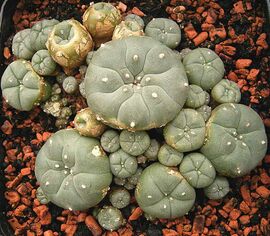Lophophora williamsii
Lophophora williamsii, also known as peyote or peyotel, is a slow growing spineless cactus with psychoactive alkaloids like mescaline and pellotine.[1] Native North Americans are likely to have used peyote, often for spiritual purposes, for at least 5,500 years.[2]
| Lophophora williamsii | |
|---|---|
 Peyote in a pot. |
|
| Taxonomical nomenclature | |
| Kingdom | Plantae |
| Unranked | Angiosperms |
| Unranked | Eudicots |
| Unranked | Core eudicots |
| Order | Caryophyllales |
| Family | Cactaceae |
| Genus | Lophophora |
| Species | L. williamsii |
| Common nomenclature | |
| Common names | Peyote, Peyotel (in Latin America) |
| Constituents | |
| Active constituents | Mescaline, Pellotine, Hordenine, etc. |
Alkaloids in different Lophophora species
According to the study by Dr. Štarha,[3] all varieties of peyote contain approximately 0.7 mg of mescaline per gram of living plant. Both Lophophora diffusa and Lophophora fricii are found to be low in mescaline and high in pellotine.
| Alkaloid | L. williamsii | L. jourdaniana | L. diffusa | L. fricii | L. koehresii |
|---|---|---|---|---|---|
| Tyramine | 0.5 - 1 | 0.6 | 0.1 | 0.1 | 0.1 |
| Hordenine | 5 - 8 | 2 - 9 | 0.5 | 0.4 | 0.4 |
| Mescaline | 15 - 30 | 31 | 1.2 | 1.1 | 1.3 |
| Pellotine | 14 - 17 | 17.8 | 86.2 | 65.2 | 88.4 |
| Anhalonidine | 14 | 20.1 | 3.8 | 25.9 | 3.5 |
External links
References
- ↑ http://www.ncbi.nlm.nih.gov/pubmed/5065448
- ↑ El-Seedi HR, De Smet PA, Beck O, Possnert G, Bruhn JG (October 2005). "Prehistoric peyote use: alkaloid analysis and radiocarbon dating of archaeological specimens of Lophophora from Texas". J Ethnopharmacol.
- ↑ Grym, Rudolf (1997). Rod/Die Gattung Lophophora. Bratislava: Vydavateľstvo Roman Staník. ISBN 80-900933-9-6. [The book features an appendix on Lophophora chemistry by Dr Roman Štarha.]